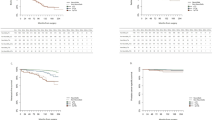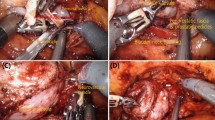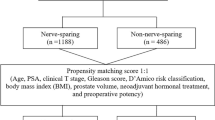Abstract
Background
To compare surgical, pathological, and functional outcomes of patients undergoing NeuroSAFE-guided RARP vs. RARP alone.
Methods
In February 2024, a literature search and assessment was conducted through PubMed®, Scopus®, and Web of Science™, to retrieve data of men with PCa (P) undergoing RARP with NeuroSAFE (I) versus RARP without NeuroSAFE (C) to evaluate surgical, pathological, oncological, and functional outcomes (O), across retrospective and/or prospective comparative studies (Studies). Surgical (operative time [OT], number of nerve-sparing [NS] RARP, number of secondary resections after NeuroSAFE), pathological (PSM), oncological (biochemical recurrence [BCR]), and functional (postoperative continence and sexual function recovery) outcomes were analyzed, using weighted mean difference (WMD) for continuous variables and odd ratio (OR) for dichotomous variables.
Results
Overall, seven studies met the inclusion criteria (one randomized clinical trial, one prospective non-randomized trial and five retrospective studies) and were eligible for SR and MA. A total of 4,207 patients were included in the MA, with 2247 patients (53%) undergoing RARP with the addition of NeuroSAFE, and 1 960 (47%) receiving RARP alone. The addition of NeuroSAFE enhanced the likelihood of receiving a nerve-sparing (NS) RARP (OR 5.49, 95% CI 2.48–12.12, I2 = 72%). In the NeuroSAFE cohort, a statistically significant reduction in the likelihood of PSM at final pathology (OR 0.55, 95% CI 0.39–0.79, I2 = 73%) was observed. Similarly, a reduced likelihood of BCR favoring the NeuroSAFE was obtained (OR 0.47, 95% CI 0.35–0.62, I2 = 0%). At 12-month postoperatively, NeuroSAFE led to a significantly higher likelihood of being pad-free (OR 2.01, 95% CI 1.25–3.25, I2 = 0%), and of erectile function recovery (OR 3.50, 95% CI 2.34–5.23, I2 = 0%).
Conclusion
Available evidence suggests that NeuroSAFE might represent a histologically based approach to NVB preservation, broadening the indications of NS RARP, reducing the likelihood of PSM and subsequent BCR. In addition, it might translate into better functional postoperative outcomes. However, the current body of evidence is mostly derived from non-randomized studies with a high risk of bias.
This is a preview of subscription content, access via your institution
Access options
Subscribe to this journal
Receive 4 print issues and online access
$259.00 per year
only $64.75 per issue
Buy this article
- Purchase on SpringerLink
- Instant access to full article PDF
Prices may be subject to local taxes which are calculated during checkout




Similar content being viewed by others
Data availability
Sheets containing raw data (extracted variables, statistical analyses) are available upon reasonable request from the corresponding author.
References
Dasgupta P, Patil K, Anderson C, Kirby R. Transition From Open To Robotic‐Assisted Radical Prostatectomy. BJU Int. 2008;101:667–8.
Cornford P, van den Bergh RCN, Briers E, Van den Broeck T, Brunckhorst O, Darraugh J, et al. EAU-EANM-ESTRO-ESUR-ISUP-SIOG Guidelines on Prostate Cancer—2024 Update. Part I: Screening, Diagnosis, and Local Treatment with Curative Intent. Eur Urol. 2024;86:148–63.
Ilic D, Evans SM, Allan CA, Jung JH, Murphy D, Frydenberg M. Laparoscopic and robotic-assisted versus open radical prostatectomy for the treatment of localised prostate cancer. Cochrane Database Syst Rev. 2017;9:CD009625.
Tewari AK, Srivastava A, Huang MW, Robinson BD, Shevchuk MM, Durand M, et al. Anatomical grades of nerve sparing: a risk‐stratified approach to neural‐hammock sparing during robot‐assisted radical prostatectomy (RARP). BJU Int. 2011;108:984–92.
Moris L, Gandaglia G, Vilaseca A, Van den Broeck T, Briers E, De Santis M, et al. Evaluation of Oncological Outcomes and Data Quality in Studies Assessing Nerve-sparing Versus Non–Nerve-sparing Radical Prostatectomy in Nonmetastatic Prostate Cancer: A Systematic Review. Eur Urol Focus 2022;8:690–700.
Eissa A, Zoeir A, Sighinolfi MC, Puliatti S, Bevilacqua L, Del Prete C, et al. “Real-time” Assessment of Surgical Margins During Radical Prostatectomy: State-of-the-Art. Clin Genitourin Cancer. 2020;18:95–104.
Bianchi L, Chessa F, Angiolini A, Cercenelli L, Lodi S, Bortolani B, et al. The Use of Augmented Reality to Guide the Intraoperative Frozen Section During Robot-assisted Radical Prostatectomy. Eur Urol. 2021;80:480–8.
Oxley J, Bray A, Rowe E. Could a Mohs technique make Neuro <scp>SAFE</scp> a viable option? BJU Int. 2018;122:358–9.
Öbek C, Saglican Y, Ince U, Argun OB, Tuna MB, Doganca T, et al. Intra-surgical total and re-constructible pathological prostate examination for safer margins and nerve preservation (Istanbul preserve). Ann Diagn Pathol. 2018;33:35–9.
Fosså SD, Beyer B, Dahl AA, Aas K, Eri LM, Kvan E, et al. Improved patient-reported functional outcomes after nerve-sparing radical prostatectomy by using NeuroSAFE technique. Scand J Urol. 2019;53:385–91.
Preisser F, Theissen L, Wild P, Bartelt K, Kluth L, Köllermann J, et al. Implementation of Intraoperative Frozen Section During Radical Prostatectomy: Short-term Results from a German Tertiary-care Center. Eur Urol Focus 2021;7:95–101.
Beyer B, Schlomm T, Tennstedt P, Boehm K, Adam M, Schiffmann J, et al. A Feasible and Time-efficient Adaptation of NeuroSAFE for da Vinci Robot-assisted Radical Prostatectomy. Eur Urol. 2014;66:138–44.
Schlomm T, Tennstedt P, Huxhold C, Steuber T, Salomon G, Michl U, et al. Neurovascular Structure-adjacent Frozen-section Examination (NeuroSAFE) Increases Nerve-sparing Frequency and Reduces Positive Surgical Margins in Open and Robot-assisted Laparoscopic Radical Prostatectomy: Experience After 11 069 Consecutive Patients. Eur Urol. 2012;62:333–40.
Mirmilstein G, Rai BP, Gbolahan O, Srirangam V, Narula A, Agarwal S, et al. The neurovascular structure‐adjacent frozen‐section examination (Neuro <scp>SAFE</scp>) approach to nerve sparing in robot‐assisted laparoscopic radical prostatectomy in a British setting – a prospective observational comparative study. BJU Int. 2018;121:854–62.
Dinneen E, Haider A, Grierson J, Freeman A, Oxley J, Briggs T, et al. NeuroSAFE frozen section during robot‐assisted radical prostatectomy: peri‐operative and histopathological outcomes from the NeuroSAFE PROOF feasibility randomized controlled trial. BJU Int. 2021;127:676–86.
Dinneen EP, Van Der Slot M, Adasonla K, Tan J, Grierson J, Haider A, et al. Intraoperative Frozen Section for Margin Evaluation During Radical Prostatectomy: A Systematic Review. Eur Urol Focus. 2020;6:664–73.
Page MJ, McKenzie JE, Bossuyt PM, Boutron I, Hoffmann TC, Mulrow CD, et al. The PRISMA 2020 statement: an updated guideline for reporting systematic reviews. BMJ 2021;372:n71.
Kumar A, Patel VR, Panaiyadiyan S, Seetharam Bhat KR, Moschovas MC, Nayak B. Nerve-sparing robot-assisted radical prostatectomy: Current perspectives. Asian J Urol. 2021;8:2–13.
Tal R, Alphs HH, Krebs P, Nelson CJ, Mulhall JP. Erectile Function Recovery Rate after Radical Prostatectomy: A Meta-Analysis. J Sex Med. 2009;6:2538–46.
McGrath S, Zhao X, Steele R, Thombs BD, Benedetti A, Levis B, et al. Estimating the sample mean and standard deviation from commonly reported quantiles in meta-analysis. Stat Methods Med Res. 2020;29:2520–37.
Hozo SP, Djulbegovic B, Hozo I. Estimating the mean and variance from the median, range, and the size of a sample. BMC Med Res Methodol. 2005;5:13.
Ades AE, Lu G, Higgins JPT. The Interpretation of Random-Effects Meta-Analysis in Decision Models. Med Decis Mak. 2005;25:646–54.
Sterne JAC, Savović J, Page MJ, Elbers RG, Blencowe NS, Boutron I, et al. RoB 2: a revised tool for assessing risk of bias in randomised trials. BMJ 2019;366:l4898.
Sterne JA, Hernán MA, Reeves BC, Savović J, Berkman ND, Viswanathan M, et al. ROBINS-I: a tool for assessing risk of bias in non-randomised studies of interventions. BMJ 2016;355:i4919.
McGuinness LA, Higgins JPT. Risk‐of‐bias VISualization (robvis): An R package and Shiny web app for visualizing risk‐of‐bias assessments. Res Synth Methods. 2021;12:55–61.
Shea BJ, Reeves BC, Wells G, Thuku M, Hamel C, Moran J, et al. AMSTAR 2: a critical appraisal tool for systematic reviews that include randomised or non-randomised studies of healthcare interventions, or both. BMJ 2017;358:j4008.
van der Slot MA, den Bakker MA, Tan TSC, Remmers S, Busstra MB, Gan M, et al. <scp>NeuroSAFE</scp> in radical prostatectomy increases the rate of nerve‐sparing surgery without affecting oncological outcome. BJU Int. 2022;130:628–36.
Köseoğlu E, Kulaç İ, Armutlu A, Gürses B, Seymen H, Vural M, et al. Intraoperative Frozen Section via Neurosafe During Robotic Radical Prostatectomy in the Era of Preoperative Risk Stratifications and Primary Staging With mpMRI and PSMA-PET CT: Is There a Perfect Candidate? Clin Genitourin Cancer. 2023;21:602–11.
Leitsmann C, Uhlig A, Bremmer F, Mut TT, Ahyai S, Reichert M, et al. Impact of mpMRI targeted biopsy on intraoperative nerve‐sparing (NeuroSAFE) during robot‐assisted laparoscopic radical prostatectomy. Prostate 2022;82:493–501.
Sooriakumaran P, Dev HS, Skarecky D, Ahlering T. The importance of surgical margins in prostate cancer. J Surg Oncol. 2016;113:310–5.
Zhang L, Wu B, Zha Z, Zhao H, Jiang Y, Yuan J. Positive surgical margin is associated with biochemical recurrence risk following radical prostatectomy: a meta-analysis from high-quality retrospective cohort studies. World J Surg Oncol. 2018;16:124.
Steineck G, Bjartell A, Hugosson J, Axén E, Carlsson S, Stranne J, et al. Degree of Preservation of the Neurovascular Bundles During Radical Prostatectomy and Urinary Continence 1 Year after Surgery. Eur Urol. 2015;67:559–68.
Sighinolfi MC, Eissa A, Spandri V, Puliatti S, Micali S, Reggiani Bonetti L, et al. Positive surgical margin during radical prostatectomy: overview of sampling methods for frozen sections and techniques for the secondary resection of the neurovascular bundles. BJU Int. 2020;125:656–63.
Vis AN, Nieuwenhuijzen JA, Veerman H, Roeleveld T, Wit E, van der Sluis TM, et al. NeuroSAFE remains an investigational, debatable, laborious (expensive) procedure. BJU Int. 2023;131:131–2.
van der Slot MA, den Bakker MA, Klaver S, Kliffen M, Busstra MB, Rietbergen JBW, et al. Intraoperative assessment and reporting of radical prostatectomy specimens to guide nerve‐sparing surgery in prostate cancer patients (NeuroSAFE). Histopathology 2020;77:539–47.
Herlemann A, Meng MV. Editorial: Conversion to negative surgical margin after intraoperative frozen section – (un)necessary effort and relevance in 2019? BJU Int. 2019;123:744–6.
Walsh PC, Donker PJ. Impotence Following Radical Prostatectomy: Insight Into Etiology and Prevention. J Urol. 1982;128:492–7.
Schatloff O, Chauhan S, Sivaraman A, Kameh D, Palmer KJ, Patel VR. Anatomic Grading of Nerve Sparing During Robot-Assisted Radical Prostatectomy. Eur Urol. 2012;61:796–802.
Tewari A, Peabody JO, Fischer M, Sarle R, Vallancien G, Delmas V, et al. An Operative and Anatomic Study to Help in Nerve Sparing during Laparoscopic and Robotic Radical Prostatectomy. Eur Urol. 2003;43:444–54.
Moschovas MC, Patel V. Nerve-sparing robotic-assisted radical prostatectomy: how I do it after 15.000 cases. Int Braz J Urol. 2022;48:369–70.
Meeks JJ, Eastham JA. Radical prostatectomy: Positive surgical margins matter. Urologic Oncol: Semin Original Investig. 2013;31:974–9.
Preston MA, Carrière M, Raju G, Morash C, Doucette S, Gerridzen RG, et al. The Prognostic Significance of Capsular Incision Into Tumor During Radical Prostatectomy. Eur Urol. 2011;59:613–8.
Preisser F, Heinze A, S. Abrams‐Pompe R, Budäus L, Chun FK‐H, Graefen M, et al. Impact of positive surgical margin length and Gleason grade at the margin on oncologic outcomes in patients with nonorgan‐confined prostate cancer. Prostate. 2022;82:949–56.
Kates M, Sopko NA, Han M, Partin AW, Epstein JI. Importance of Reporting the Gleason Score at the Positive Surgical Margin Site: Analysis of 4,082 Consecutive Radical Prostatectomy Cases. J Urol. 2016;195:337–42.
Shore ND, Moul JW, Pienta KJ, Czernin J, King MT, Freedland SJ. Biochemical recurrence in patients with prostate cancer after primary definitive therapy: treatment based on risk stratification. Prostate Cancer Prostatic Dis. 2024;27:192–201.
Zaffuto E, Gandaglia G, Fossati N, Dell’Oglio P, Moschini M, Cucchiara V, et al. Early Postoperative Radiotherapy is Associated with Worse Functional Outcomes in Patients with Prostate Cancer. J Urol. 2017;197:669–75.
Menon M, Dalela D, Jamil M, Diaz M, Tallman C, Abdollah F, et al. Functional Recovery, Oncologic Outcomes and Postoperative Complications after Robot-Assisted Radical Prostatectomy: An Evidence-Based Analysis Comparing the Retzius Sparing and Standard Approaches. J Urol. 2018;199:1210–7.
Ficarra V, Rossanese M, Gilante M, Foti M, Macchione L, Mucciardi G, et al. Retzius-sparing vs. standard robot-assisted radical prostatectomy for clinically localised prostate cancer: a comparative study. Prostate Cancer Prostatic Dis. 2023;26:568–74.
Del Giudice F, Huang J, Li S, Sorensen S, Enemchukwu E, Maggi M, et al. Contemporary trends in the surgical management of urinary incontinence after radical prostatectomy in the United States. Prostate Cancer Prostatic Dis. 2023;26:367–73.
Seetharam Bhat KR, Moschovas MC, Sandri M, Reddy S, Onol FF, Noel J, et al. Stratification of Potency Outcomes Following Robot-Assisted Laparoscopic Radical Prostatectomy Based on Age, Preoperative Potency, and Nerve Sparing. J Endourol. 2021;35:1631–8.
Walz J, Epstein JI, Ganzer R, Graefen M, Guazzoni G, Kaouk J, et al. A Critical Analysis of the Current Knowledge of Surgical Anatomy of the Prostate Related to Optimisation of Cancer Control and Preservation of Continence and Erection in Candidates for Radical Prostatectomy: An Update. Eur Urol. 2016;70:301–11.
Kaye DR, Hyndman ME, Segal RL, Mettee LZ, Trock BJ, Feng Z, et al. Urinary Outcomes Are Significantly Affected by Nerve Sparing Quality During Radical Prostatectomy. Urology 2013;82:1348–54.
Boorjian SA, Eastham JA, Graefen M, Guillonneau B, Karnes RJ, Moul JW, et al. A Critical Analysis of the Long-Term Impact of Radical Prostatectomy on Cancer Control and Function Outcomes. Eur Urol. 2012;61:664–75.
Hatzichristodoulou G, Wagenpfeil S, Weirich G, Autenrieth M, Maurer T, Thalgott M, et al. Intraoperative frozen section monitoring during nerve-sparing radical prostatectomy: evaluation of partial secondary resection of neurovascular bundles and its effect on oncologic and functional outcome. World J Urol. 2016;34:229–36.
Morozov A, Barret E, Veneziano D, Grigoryan V, Salomon G, Fokin I, et al. A systematic review of nerve-sparing surgery for high-risk prostate cancer. Minerva Urol Nephrol. 2021;73:283–91.
Levinson AW, Pavlovich CP, Ward NT, Link RE, Mettee LZ, Su LM. Association of Surgeon Subjective Characterization of Nerve Sparing Quality With Potency Following Laparoscopic Radical Prostatectomy. J Urol. 2008;179:1510–4.
Sohayda C, Kupelian PA, Levin HS, Klein EA. Extent of extracapsular extension in localized prostate cancer. Urology 2000;55:382–6.
Patel VR, Sandri M, Grasso AAC, De Lorenzis E, Palmisano F, Albo G, et al. A novel tool for predicting extracapsular extension during graded partial nerve sparing in radical prostatectomy. BJU Int. 2018;121:373–82.
Zhang F, Liu CL, Chen Q, Shao SC, Chen SQ. Accuracy of multiparametric magnetic resonance imaging for detecting extracapsular extension in prostate cancer: a systematic review and meta-analysis. Br J Radio. 2019;92:20190480.
Dinneen E, Grierson J, Almeida-Magana R, Clow R, Haider A, Allen C, et al. NeuroSAFE PROOF: study protocol for a single-blinded, IDEAL stage 3, multi-centre, randomised controlled trial of NeuroSAFE robotic-assisted radical prostatectomy versus standard robotic-assisted radical prostatectomy in men with localized prostate cancer. Trials 2022;23:584.
Rocco B, Sarchi L, Assumma S, Cimadamore A, Montironi R, Reggiani Bonetti L, et al. Digital Frozen Sections with Fluorescence Confocal Microscopy During Robot-assisted Radical Prostatectomy: Surgical Technique. Eur Urol. 2021;80:724–9.
Lavery HJ, Xiao G, Nabizada‐Pace F, Mikulasovich M, Unger P, Samadi DB. ‘Mohs surgery of the prostate’: the utility of in situ frozen section analysis during robotic prostatectomy. BJU Int. 2011;107:975–9.
Petralia G, Musi G, Padhani AR, Summers P, Renne G, Alessi S, et al. Robot-assisted Radical Prostatectomy: Multiparametric MR Imaging–directed Intraoperative Frozen-Section Analysis to Reduce the Rate of Positive Surgical Margins. Radiology 2015;274:434–44.
Checcucci E, Pecoraro A, Amparore D, De Cillis S, Granato S, Volpi G, et al. The impact of 3D models on positive surgical margins after robot-assisted radical prostatectomy. World J Urol. 2022;40:2221–9.
Checcucci E, Piana A, Volpi G, Piazzolla P, Amparore D, De Cillis S, et al. Three-dimensional automatic artificial intelligence driven augmented-reality selective biopsy during nerve-sparing robot-assisted radical prostatectomy: A feasibility and accuracy study. Asian J Urol. 2023;10:407–15.
Author information
Authors and Affiliations
Contributions
Conception and design: Autorino, Ditonno; Acquisition of data: Franco, Cannoletta, Licari; Statistical analysis: Ditonno, Bologna; Interpretation of the data: Veccia, Bertolo, Checcucci, Crivellaro, Porpiglia, De Nunzio, Antonelli; Drafting of the manuscript: Ditonno; Critical revision of the manuscript for important intellectual content: Bologna, Licari, Franco, Cannoletta, Checcucci, Veccia, Bertolo, Crivellaro, Porpiglia, De Nunzio, Antonelli, Autorino Supervision: Autorino; Final approval of the version to be published: Ditonno, Bologna, Licari, Franco, Cannoletta, Checcucci, Veccia, Bertolo, Crivellaro, Porpiglia, De Nunzio, Antonelli, Autorino; Agreement to be accountable for all aspects of the work in ensuring that questions related to the accuracy or integrity of any part of the work are appropriately investigated and resolved: Ditonno, Bologna, Licari, Franco, Cannoletta, Checcucci, Veccia, Bertolo, Crivellaro, Porpiglia, De Nunzio, Antonelli, Autorino; All authors read and approved the final version of the manuscript.
Corresponding author
Ethics declarations
Competing interests
Simone Crivellaro is a consultant for Intuitive. Cosimo De Nunzio is editor in chief of Prostate Cancer Prostatic Disease.
Ethical approval
In lieu of a formal ethics committee, the principles of the Declaration of Helsinki were followed.
Additional information
Publisher’s note Springer Nature remains neutral with regard to jurisdictional claims in published maps and institutional affiliations.
Supplementary information
Rights and permissions
Springer Nature or its licensor (e.g. a society or other partner) holds exclusive rights to this article under a publishing agreement with the author(s) or other rightsholder(s); author self-archiving of the accepted manuscript version of this article is solely governed by the terms of such publishing agreement and applicable law.
About this article
Cite this article
Ditonno, F., Bologna, E., Licari, L.C. et al. Neurovascular structure-adjacent frozen-section examination (NeuroSAFE) during robot-assisted radical prostatectomy: a systematic review and meta-analysis of comparative studies. Prostate Cancer Prostatic Dis 28, 623–631 (2025). https://doi.org/10.1038/s41391-024-00891-3
Received:
Revised:
Accepted:
Published:
Issue date:
DOI: https://doi.org/10.1038/s41391-024-00891-3
This article is cited by
-
Predicting side-specific extraprostatic extension in prostate cancer using an 18F-DCFPyL PSMA-PET/CT–based nomogram
Prostate Cancer and Prostatic Diseases (2025)
-
Next-Generation Nerve-Sparing Techniques in Robotic Radical Prostatectomy: A Contemporary Review
Current Urology Reports (2025)
-
Neurovascular structure-adjacent frozen-section examination vs. standard robot-assisted radical prostatectomy: a systematic review and meta-analysis of two-arm comparative studies on functional and oncological outcomes
Journal of Robotic Surgery (2025)



